Gardening in pots and containers is a fantastic way to bring greenery into small spaces, balconies, or urban environments where traditional gardening isn’t possible. However, despite the convenience and beauty of container gardening, many gardeners unknowingly make mistakes that can lead to the decline or even death of their plants. If you want your plants to thrive and flourish, it’s crucial to avoid certain common pot-related errors.
This article highlights the key mistakes you should never make with your pots to ensure a healthy, thriving garden.
Mistake #1: Using Pots Without Drainage Holes
One of the most common reasons plants die in pots is poor drainage. Many containers—especially decorative ones—lack drainage holes, causing water to accumulate at the bottom. This creates waterlogged soil, depriving roots of oxygen and encouraging root rot and fungal diseases.
Why drainage matters:
Plants need well-aerated soil for healthy root development. Excess water suffocates roots, leading to decay and ultimately killing the plant.
Solution:
Always use pots with drainage holes. If you have pots without holes, either drill some yourself or use them as decorative outer pots and keep your plant in a proper drainage pot inside.
Mistake #2: Using Heavy or Inappropriate Soil Mix
Garden soil is often too dense and heavy for container gardening. Using regular garden soil in pots leads to compaction, poor drainage, and root stress.
Why soil choice is critical:
Potted plants need a light, well-draining potting mix that retains moisture but doesn’t stay soggy. The right mix provides oxygen and nutrients while allowing excess water to escape.
Solution:
Buy or prepare a good-quality potting mix specifically formulated for container plants. You can also mix your own with components like peat moss, coconut coir, perlite, and compost for balanced drainage and nutrient retention.
Mistake #3: Overwatering or Underwatering
Both overwatering and underwatering are frequent killers of potted plants.
-
Overwatering saturates the soil, causing root rot and fungal problems.
-
Underwatering stresses plants, leading to dry roots, wilting, and poor growth.
How to water correctly:
Check soil moisture before watering by inserting your finger about an inch deep. If it feels dry, it’s time to water. Ensure water flows freely from drainage holes. Avoid leaving pots standing in saucers full of water.
Mistake #4: Ignoring Pot Size and Plant Growth
Using pots that are too small for your plant’s root system restricts growth and leads to poor plant health. Conversely, pots that are too large can retain excessive moisture, risking root rot.
Why pot size matters:
Plants need enough space to grow roots and absorb nutrients. Crowded roots limit water uptake and can cause stress.
Solution:
Choose pots appropriate to the size and growth rate of your plant. Repot when roots start circling the pot or emerge from drainage holes, moving to a pot slightly larger than the previous one.
Mistake #5: Not Fertilizing Container Plants Properly
Potted plants have limited soil and nutrient reserves. Without regular feeding, they can quickly become nutrient deficient, resulting in weak growth, yellowing leaves, or poor flowering.
Why fertilizing is essential:
Container soil loses nutrients with watering and plant uptake, so replenishment is necessary.
Solution:
Use balanced, slow-release fertilizers or organic liquid feeds every few weeks during the growing season. Be careful not to overfertilize, as this can burn roots.
Mistake #6: Neglecting Sunlight and Placement
Plants have specific light requirements. Placing a sun-loving plant in deep shade or a shade-preferring plant in direct, hot sun causes stress, leaf burn, or poor growth.
How to avoid light-related issues:
Learn about your plants’ light preferences and place them accordingly. Rotate pots occasionally to promote even growth.
Mistake #7: Failing to Clean and Maintain Pots
Dirty pots can harbor pests and diseases that infect new plants. Residual salt buildup or old soil can also negatively affect plant health.
Good maintenance habits:
Clean pots with soapy water and rinse thoroughly before reuse. Scrub off salt deposits and remove old soil. Sterilize pots if previous plants had diseases.
Bonus Tips for Healthy Container Gardening
-
Use saucers carefully: Use saucers to catch excess water but empty them regularly to avoid waterlogging.
-
Mulch pots: Apply a thin layer of organic mulch on soil surface to retain moisture and reduce temperature fluctuations.
-
Choose the right pot material: Terracotta pots are porous and good for dry-loving plants, while plastic retains moisture longer.
-
Avoid sudden temperature changes: Protect pots from frost or extreme heat that can damage roots.
Conclusion
Container gardening offers great flexibility and joy, but success depends on avoiding common mistakes that can endanger your plants. By ensuring proper drainage, using the right soil, watering carefully, choosing the correct pot size, fertilizing appropriately, providing the right light, and maintaining clean pots, you’ll create a thriving environment for your plants.
Remember, your pots are more than just containers — they’re the foundation of your plant’s health. Treat them well, and your garden will reward you with lush, vibrant growth all year round.



